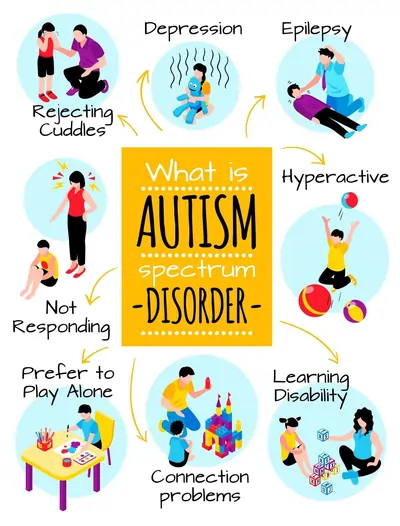
Understanding Autism Symptoms: A Comprehensive Guide

Autism Spectrum Disorder (ASD) is a complex neurodevelopmental condition that affects individuals in a variety of ways. It’s important to note that autism is a spectrum, meaning the symptoms and their severity can vary widely from person to person. This guide provides an overview of common symptoms associated with autism , categorized into several key areas.
1. Social Communication Challenges

1.1 Difficulty with Social Interactions Individuals with disorders often struggle with social interactions. They may find it challenging to understand social cues and respond appropriately. This can manifest as difficulty initiating or maintaining conversations, limited use of nonverbal communication like eye contact or gestures, and a preference for solitary activities.
1.2 Problems with Understanding Social Norms Understanding and interpreting social norms can be challenging. For example, individuals with disorders might have trouble grasping unwritten rules of social behavior, such as taking turns in conversation or recognizing when someone is upset.
1.3 Challenges in Empathy Empathy, or the ability to understand and share the feelings of others, can be difficult for those with disorders. They may not easily recognize emotional cues in others or may struggle to express their own emotions in a way that others find relatable.
2. Repetitive Behaviors and Restricted Interests

2.1 Repetitive Movements or Speech Repetitive behaviors, such as hand-flapping, rocking, or repeating phrases, are common. These actions can provide a sense of comfort or serve as a coping mechanism for stress or anxiety.
2.2 Strong Focus on Specific Interests Individuals with disorders often develop intense and narrow interests. These can become all-consuming, with a person dedicating significant time and energy to learning about or engaging in their specific area of interest, whether it’s trains, dinosaurs, or a particular topic.
2.3 Adherence to Routines A strong preference for routines and consistency is another common symptom. Changes in routine or unexpected events can cause significant distress. Individuals might become upset if their daily schedule is altered or if they are unable to follow their usual patterns.
3. Sensory Sensitivities

3.1 Hyper- or Hypo-Sensitivity to Sensory Input Autistic individuals often experience heightened or reduced sensitivity to sensory stimuli. This can include sensitivities to light, sound, texture, or smell. For example, certain sounds might be perceived as overwhelmingly loud, or particular textures might be unbearable to touch.
3.2 Sensory Processing Issues Challenges with sensory processing can lead to difficulties in filtering out irrelevant sensory information. This can affect concentration and lead to sensory overload, where too much input becomes overwhelming and distressing.
4. Cognitive and Behavioral Characteristics

4.1 Differences in Learning and Problem-Solving Cognitive processing in autisms can vary significantly. Some individuals may have exceptional skills in specific areas, such as mathematics or memory, while others may face difficulties with abstract thinking or problem-solving.
4.2 Unusual Responses to Pain or Discomfort Responses to physical pain or discomfort can be atypical. Some individuals may not respond to pain in the expected way, while others might exhibit exaggerated reactions.
6. Diagnosis and Assessment
6.1 Diagnostic Criteria The diagnosis of autisms is based on criteria outlined in the Diagnostic and Statistical Manual of Mental Disorders (DSM-5). This includes a range of symptoms related to social communication and restricted, repetitive patterns of behavior. Diagnosis typically involves a comprehensive evaluation by a team of professionals, including psychologists, pediatricians, and speech therapists.
6.2 Importance of Early Intervention Early diagnosis and intervention are crucial for supporting individuals with autism. Early support can help in developing communication skills, social interactions, and adaptive behaviors. Interventions might include behavioral therapy, speech therapy, and educational support.
7. Individual Variability and Personalization of Support
7.1 Emphasizing Individual Differences It’s essential to remember that autism presents differently in each individual. The symptoms and severity can vary greatly, and what works for one person may not work for another. Personalized approaches to support and intervention are key to addressing the unique needs of each individual.
7.2 The Role of Family and Community Support Family and community play a vital role in the lives of individuals with autism. Support from loved ones, as well as inclusive practices within communities and educational systems, can significantly impact the well-being and development of individuals with autism.
8. Misconceptions and Stigma
8.1 Common Misconceptions There are many misconceptions about autism, such as the belief that individuals with autism lack empathy or are unable to form relationships. These misconceptions can contribute to stigma and misunderstandings. It’s important to approach autism with an open mind and accurate information.
8.2 Addressing Stigma Combating stigma involves promoting awareness and understanding of autism. Education and advocacy are crucial in fostering a more inclusive and supportive environment for individuals with autism and their families.
9. Conclusion
Understanding autism symptoms is crucial for providing effective support and creating an inclusive society. By recognizing the diverse ways in which autism can manifest, we can better appreciate the unique strengths and challenges faced by individuals with autism. Early intervention, personalized support, and ongoing education are key to ensuring that individuals with autism can lead fulfilling and meaningful.
You may also like to read:




